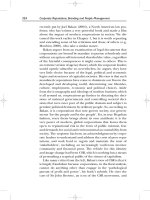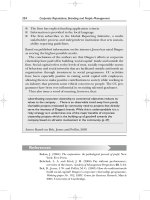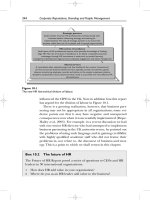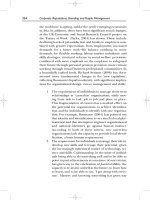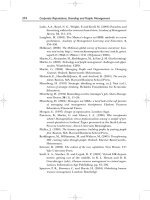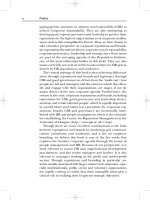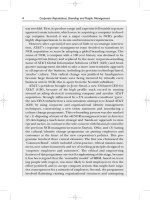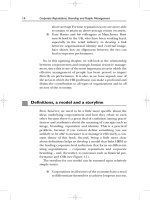Tài liệu Corporate Reputations, Branding and People Management 12 pdf
Bạn đang xem bản rút gọn của tài liệu. Xem và tải ngay bản đầy đủ của tài liệu tại đây (126.29 KB, 10 trang )
media and investor needs to hold individuals, rather than teams
of leaders, to account and the need to make news (Kellerman,
2004). We return to this issue in a discussion of Hurricane
Katrina later in this chapter.
Another illustration of this relationship has been the creation
of the Beckham brand. David Beckham, who is one of the world’s
most famous footballers and has become an icon among teen-
agers in Asia and Europe, is behind one of the best-known per-
sonal brands. It is often suggested, however, he owes his image to
his ability to appeal to many different groups, all of whom can
project on him what they will – footballer, star symbol, family man,
new man and even saviour of English national identity through
football. In other words, he is, according to some observers, a
media and consumer creation with a celebrity status extending
far beyond his abilities as a footballer. (The same argument can
be applied to the ‘celebrities’ of reality TV shows whose reputa-
tions have grown because of a complicit relationship with the
media in creating them and the market for ‘non-celebrities’.) It is
argued that Manchester United, the club with which he grew up
and who helped him build his image, were happy to transfer him
to Real Madrid because the Beckham image had become ‘bigger
than the club’ and detracted from the team that had shaped his
football (and, in part, commercial) success. For example, his man-
ager, Sir Alex Ferguson, accused him of playing (long, showy)
‘Hollywood’ passes that were intended to enhance his own
image, often to the detriment of his team members and the club
(because they cut out his midfield colleagues and had little regard
for the ability of the receiver to deal with the long ball). This is
only one of many illustrations that show the dark side of talent
management, a topic we explore in Chapter 6, often revealing
tensions between individuals whose image is created by sig-
nificant outsiders and the collective identity of the internal
teams they work with. Good examples here are the ‘stars’ of the
knowledge-intensive industries such as financial investment,
consulting, medicine and academia, whose external reputations
are effectively ‘rented’ by the organizations that employ them.
As we have noted in our discussion of cosmopolitans and locals,
tensions often arise between such talented individuals and the
groups they work with (and which often help create their ‘star-
dom’) (Groysberg et al., 2004).
94 Corporate Reputations, Branding and People Management
Multiple identities and the ‘AC
3
ID test’
Another helpful way of thinking about the identity-image rela-
tionship has been developed by John Balmer and Stephen
Geyser (2003). They seek to apply the concepts of identity to
the whole field of corporate-level studies, which they argue can
cohere around the management of these multiple identities of a
corporation (though this is a different usage of multiple identities
to our own). As a result, they have proposed a multi-disciplinary
approach – now called the AC
3
ID framework – to the manage-
ment of image and identity. According to them, identity has five
meanings which incorporate not only the previously discussed
organizational identity and image but also other corporate-level
concepts such as corporate identity, strategic vision and corpor-
ate strategy (see Figure 3.4).
Chapter 3 Organizational identity, action and image: the linchpin 95
A
Actual or
(organizational
identity)
C
Conceived or
(corporate
image)
I
Ideal or
(corporate
strategy)
C
Communicated
or (corporate
identity)
D
Desired or
(corporate
vision)
C
Covenanted
identity (brand
promise)
Figure 3.4
The AC
3
ID framework (adapted from Balmer and Geyser, 2003,
p. 17; Balmer and Stuart, 2005).
■ The actual identity is defined as the current attributes
of the corporation, including the management values,
leadership styles, organizational structure, business
activities and markets, and the range of products and
services.
■ The conceived identity refers to the past, present and
future perceptions of internal and external stakehold-
ers, close to Hatch and Schultz’s image and identity
relationship, and to reputation.
■ The ideal identity, which is the optimum positioning
of the corporation in its given markets at a point in
time, based on an analysis of external environmen-
tal–internal resources fit. This identity is associated
with the work of strategic planners and is close to the
notion of corporate strategy and strategic positioning.
■ The desired identity is synonymous with the vision of
the organization held by its leadership. It is not the
same thing as ideal identity, which is mostly the result
of serious analysis. The desired identity is very often a
personal and egotistical statement made by senior lead-
ers, but which is no less important in its consequences
than ideal identities.
■ The communicated identity is the ‘official’ identity put
into the public domain through the corporate commu-
nications function – the official rhetoric of the organiza-
tion that communicates what the organization wishes
to be. It is also, however, communicated by less contro-
llable media, such as ‘word of mouth’ and the financial
press, which requires a great deal of management time
spent on internal communications and public relations.
■ The covenanted identity, which is the ‘promise’ made
by the brand to persuade us to place our trust and
confidence in it and to continue to support it through
repeat ‘purchases’ and recommendations.
The main practical value of this framework is the proposition
that all five identities need to be broadly aligned over time.
Balmer and Geyser maintain that if any two of these are out of
alignment at a particular point, this will be manifested as a
‘moment of truth’ from which a corporation’s reputation is in
96 Corporate Reputations, Branding and People Management
danger of suffering serious damage. So, for example, the dan-
gers of communicated identity (or corporate identity) running
ahead of the actual identity (or organizational identity) can, as
we discuss in later chapters, lead to persistent cynicism among
employees and also lead to distrust among customers if this
cynicism is communicated by disaffected employees. Another
example is redundancies or retrenchments that lead to mass
disaffection among employees (negative organizational iden-
tity) who are simultaneously being exhorted to ‘live the brand’
image that ‘puts people first’ (the conceived identity). So, Jeff
Pfeffer (2005) has argued that as ‘employees are increasingly
disengaged and distrustful of their employers, organizations
have moved to become less like communities and adopt more
arm’s-length and distant relationships with their people. Organ-
izations that are more communal have arrangements for help-
ing employees in need … are better at resolving work–family
issues, and foster long-term employment relations’ (p. 1).
The Balmer and Geyser model has been applied to the
analysis of British Airways progress over the past few decades
(see Box 3.2).
Chapter 3 Organizational identity, action and image: the linchpin 97
Box 3.2 The changing identities of British Airways (BA)
BA can be traced to 1924 when four small airlines merged to form
Imperial Airways, encouraged by the British government. It operated as
a virtual monopoly until 1935, when British Airways was established to
further the UK’s aviation interests in South America and Europe. The
brand name temporarily disappeared but was re-established in 1974 fol-
lowing the merger of British Overseas Airways Corporation (BOAC) and
British European Airways (BEA). Balmer and Stuart trace six periods
during which there has been a mismatch in BA’s changing identities.
■ ‘Appalling’ identity (1974–1980). Following the merger of BOAC
and BEA, there were tensions between the two groups of staff, with
the former seeing themselves as superior to the latter. This mani-
fested itself in poor service which was exacerbated by the attitudes
of BA pilots, many of whom had joined from the Royal Air Force
and saw passengers as cargo to be transported, and as a near-
unnecessary evil. This became a major problem for customers since
98 Corporate Reputations, Branding and People Management
the airline held a virtual monopoly of many routes in and out of
Heathrow. BA came to stand for ‘Bloody Awful’.
■ ‘Adjusting identity’ (1981–1983). Margaret Thatcher gave Sir John
King the chairmanship to turn it around from a loss-making nation-
alized carrier to a profitable private sector organization. Inheriting
a huge overdraft, King and his new board embarked on a series of
initiatives to improve employee morale and self-image, which was
seen to be a major problem. This included an expensive advertise-
ment, called the Manhattan ad, that was designed to change the
identity and self-respect of employees as much as convince custo-
mers that the airline was changing.
■ ‘Appealing identity’ (1984–1987). King and his new CEO, Sir Colin
Marshall, who had a service industry background, were experienced
communicators, who recognized the need to change the image and
self-image of the company to improve customer service. This began
with a major culture change programme called ‘Putting People First’,
in which Marshall led from the front. It was also a period during
which BA introduced a new livery that emphasized its ‘Britishness’,
incorporating the Union Jack flag and a coat of arms. There is evi-
dence, however, that this culture change programme had only a
limited impact, especially among lower levels of employees.
■ ‘Adoring identity’ (1988–1995). BA adopted the claim that it was ‘the
world’s favourite airline’, which was supported by customer satisfac-
tion surveys. King and Marshall were insistent that this brand pro-
mise was supported by employee behaviour and HR became a major
player in delivering the brand warrant.
■ ‘Ailing identity’ (1996–2000). Robert Ayling became CEO in 1996 in
its lead up to privatization in 1997. Ayling and his team determined
that BA had to change its image from being Britain’s national
flag carrier to an international business, since more than 60% of its
customers were non-UK citizens. It was during this period that BA
changed its communicated identity by, among other design efforts,
introducing a series of international images on the tailfins. This
soon became seen a major mistake when Margaret Thatcher descri-
bed them as ‘appalling’. Employees resented the changes, especially
since they cost £60 million, and Richard Branson of Virgin exploited
the criticism of many US customers that they wanted BA to look
more British, by changing the livery of Virgin airlines to carry the
Union Jack. The ethnic tailfins were replaced after two years and
